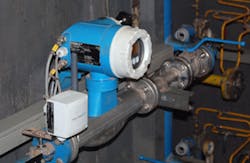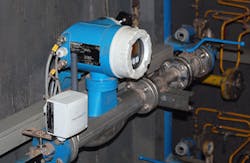While wireless has been used for select applications for decades—think radar or satellite communication—there has been a clear push over the past five years to produce technologies and methodologies to enable more widespread use in industrial and process manufacturing environments. The proliferation of wireless devices and communication strategies continues today, as the cost of installation gives wireless an obvious advantage over traditional hard-wired systems in certain scenarios. Wireless, however, is not a panacea, with several key limitations tempering its uptake and making it unlikely to surpass wired communication in the foreseeable future.
Low-Hanging Fruit
The majority of wireless applications today are designed to provide process monitoring where there was no visibility previously or manual monitoring was required. Some of the applications that represent obvious fits for wireless include:
- Inventory Control: Bulk commodities stored in tank farms, especially at remote locations and/or customer tanks.
- Energy Management: Collecting process variables (water, air, gas, electricity, and steam) to help identify and reduce the consumption of these through the production value chain.
- Pipeline Monitoring: Monitoring pumping stations and instruments in remote locations.
- Pilot Projects: Enabling experimentation to identify the best location for sensor placement.
Beyond Process Monitoring
In addition to adding visibility to the process, wireless is also being employed for certain control applications. However, latency is an issue that has limited the reach of wireless for control-based scenarios. “Most I/O protocols for control cannot handle the latency required of wireless networks,” says Michael Robinson, solutions business manager for Endress+Hauser Inc. “Users can, and have, worked their way around this by using [wireless] in control applications where process loop times are two to three times slower than the update of the wireless network.”
Ultimately, Robinson says the application itself will determine if wireless is a good fit. If the application requires a response time better than 100 milliseconds, it’s probably not suited for current-generation wireless communication. “Until there are some technological advances, it will still be some time before wireless can compete with traditional wired solutions for control applications,” says Robinson.
Key Considerations
According to Robinson, the crucial first step end-users must take in developing a wireless implementation strategy is conducting a thorough evaluation of existing infrastructure before designing the wireless network. “There is a tendency to make too many assumptions when deploying a wireless network, and the rapid adoption of wireless in the consumer space assists in this mindset—it’s wireless and it just works,” says Robinson. “We can’t make those assumptions in the process space. There are existing radio communications, building infrastructure, and other process equipment that can dramatically impact how the wireless radios perform. These need to be identified and rectified in advance.”
Mark Spindler, chief technology operator for The Lakeland Companies and vice-president of Control Assemblies Co., a member of the Control System Integrators Association, says getting the first wireless device up and running is the hardest part. “Once you have that first one in, you have the infrastructure in place to do more,” he says.
Further, Spindler says the mesh networking capability of most modern wireless devices helps mitigate some of the issues end-users might encounter with existing infrastructure and/or signal interference. “With mesh networking, each device is capable of serving as a router for any other device,” says Spindler. “So, if the distance is 1,000 feet to the base, with a mesh network you can communicate to the next closest device, which may be closer. The more devices you have, the better your ability to communicate to the base station.”
Mesh sensors are also capable of determining which nodes are available at any given time to streamline the transmission of signals back to the base station. The more mesh sensors available in a given system, the more options and the greater distance a wireless network can cover. For example, in a pipeline monitoring application, a sensor located many miles from the base station can still communicate back to the station as long as there are mesh sensors strategically positioned to serve as relays back to the base device.
Standards & Protocols
For those who have been following the recent evolution of industrial wireless technology and applications, much attention has been paid to ISA100 and WirelessHART—the two leading standards-based initiatives for industrial wireless communication. WirelessHART is a protocol designed to enable wireless communication based on the HART Communications Protocol. ISA100, on the other hand, aims to provide a suite of standards that serves as a broad-based platform for a range of wireless communication types. ISA100.11a Wireless Systems for Industrial Automation: Process Control and Related Applications is the first standard to emerge from the ISA100 program.
Although there was early discussion about some level of collaboration and convergence between ISA100 and WirelessHART as part of the ISA100.12 working group, such discussions officially ceased when members of the ISA100.12 subcommittee voted to disband in December 2012.
Toby Colquhoun, senior analyst with IHS, says he wouldn’t expect to see a unified standard for industrial wireless any time soon. “A single vendor communication standard never happened with fieldbus or industrial Ethernet technology; end-users just used the technology offered by vendors and realized the benefits,” Colquhoun says.
Add vs. Replace
While there are some obvious opportunities for wireless to add process visibility, particularly by tapping into devices that were not previously monitored, it is unlikely that we will see wireless replacing existing wired installations in the near term. “The easiest place to implement or look at wireless is in certain greenfield applications,” says Spindler. “To simply [replace] wired with wireless doesn’t make any sense to me since you already have the infrastructure.”
According to Colquhoun, even the largest deployments would be hardpressed to show more than 5 percent of process nodes are wireless. For the majority of deployments, he says the number of wireless nodes is less than 1 percent. “Process plants have a very long working life, and a consequence of this is that anything that [users] truly think is worth measuring already has had a wire run to it.” To simply [replace] wired with wireless doesn’t make any sense to me since you already have the infrastructure in place.
Next Steps
Going forward, Spindler says he sees one of the next logical applications for wireless as I/O drops. He says that while a lot of I/O is currently on Ethernet, wireless could certainly meet the needs of new applications in this area in the near term.
Colquohoun says he sees growth applications for wireless in the area of predictive maintenance. He says current iterations of condition monitoring are typically deployed on the most expensive pieces of equipment, such as generator turbines.
“The potential exists for a more pervasive condition monitoring—wireless sensors can monitor equipment for anomalous behavior, and maintenance personnel can respond appropriately before failure,” says Colquhoun. “Condition monitoring is but one example—we expect new devices in areas as diverse as safety, optimizing energy use, and environmental compliance. In some respects, growth of industrial wireless is simply limited by engineer creativity.”
Robinson says end-users should look for more devices with wireless radios embedded in them and the ability to exchange data over different protocols. He says the latency of wireless radios also needs to improve.
“While I can envision a completely wireless plant in the future, some applications in most plants still require wires, primarily due to the fact that the technology limits us in its usage,” says Robinson. “Maybe future technology will make this statement obsolete.
Matt Migliore is the director of content for Flow Control magazine and FlowControlNetwork.com. He can be reached at 610.828.1711 or [email protected].



